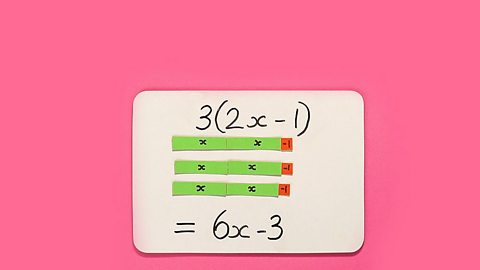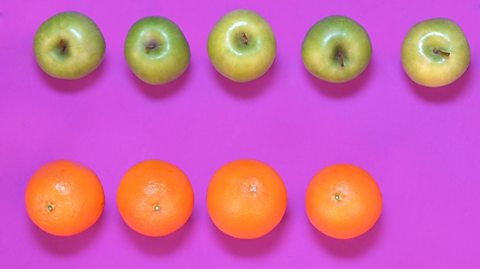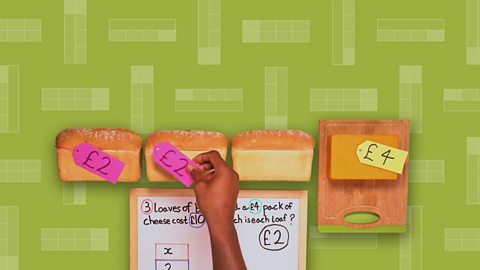Days of the week
If you are asked how many days there are in a week, you would find the answer easy - there are \(7\).
How about the number of days in two weeks?
Again, the answer is fairly straightforward - there are \(14\).
What happens when you are asked how many days there are in three weeks, four weeks or five weeks?
If you know the formula you could work this out.
Forumula for working out days in a week
\(1\) week is \(1\) Г— \(7\) days = \(7\)
\(2\) weeks is \(2\) Г— \(7\) days = \(14\)
\(3\) weeks is \(3\) Г— \(7\) days = \(21\)
\(4\) weeks is \(4\) Г— \(7\) days = \(28\)
So, the formula to work out the number of days is:
number of days = number of weeks Г— 7
Question
How many pence are there in \(\pounds{1}\)?
How many pence are there in \(\pounds{2}\)?
How many pence are there in \(\pounds{7}\)?
Write down a formula connecting the number of pence to the number of pounds.
\(100p = \pounds1\)
\(200p = \pounds2\)
\(700p = \pounds7\)
\(number of pence = number of pounds \times 100\)
Constructing formulae
The advert says that the cost of a party is ВЈ50 plus ВЈ5 per person.
So what would be the cost of a party for 10?
The cost would be:
\(\pounds{50}+(\pounds{5}\times{10})=\pounds{50}+\pounds{50}=\pounds{100}\)
Question
What would be the cost of a party for \({20}\)?
\(\pounds{50}+(\pounds{5}\times{20})=\pounds{50}+\pounds{100}=\pounds{150}\)
Working out the cost
How do you work out the cost if you don't know the number of people who will attend the party?
Call the number of people '\({n}\)'.
The cost for \({10}\) people is \(\pounds{50}+(\pounds{5}\times{10})=\pounds{100}\).
The cost for \({20}\) people is \(\pounds{50}+(\pounds{5}\times{20})=\pounds{150}\).
So the cost for \({n}\) people is \(\pounds{50}+(\pounds{5}\times{n})=\pounds({50}+{5n})\).
With this formula you can work out the cost of a party for any number of people.
Have a go at the next question to see if you can use \({n}\) in another expression.
Question
Alexa is \({12}\) years old.
How old will she be in \({n}\) years' time?
In \({n}\) years' time her age will have increased by \({n}\).
So her age will be \({n}\) more than it is now.
Her age will be:
\(12 + n\)
Check your answer.
In one year's time she will be \({13}\).
If we put \({1}\) in for the value of \({n}\) we get \(12 + 1 = 13\).
So that is correct.
In ten years' time she will be \({22}\), and putting \(n=10\) gives us:
\(age = 12 + 10 = 22\)
So the formula is correct.
Substitution
What is substitution?
When letters in a formula are replaced by numbers, it is called substitution.
Time
For the purpose of measuring time, the Earth's surface is divided into \({24}\) equal wedges of \({15}^\circ\), each called a time zone, beginning at Greenwich, London (GMT).
As you pass over each zone to the east you add \({1}\) hour to GMT, and as you pass over each zone to the west you subtract \({1}\) hour from GMT.
On this basis, call the time in London '\({g}\)'.
The formula for working out the time in Bangkok, Thailand, is \(g + 7\).
And the formula for working out the time in Santiago, Chile, is \(g - 4\).
These formulae allow us to substitute \({g}\) for any time in London to find out the time in Bangkok or Santiago.
Question
Q1. Using the formula above, find the time in Bangkok when it is \(\text{14:00}\) hours in London.
Q2. What time is it in Santiago, Chile, when the time in London is \(\text{20:00}\) hours?
A1. Time in Bangkok \(= g + 7\).
Substitute the \({14}\) for the \({g}\).
\(g + 7 = 14 + 7 = 21\)
So at \(\text{14:00}\) hours in London, the time in Bangkok is \(\text{21:00}\) hours.
A2. The formula for working out the time in Santiago is:
\(g - 4\)
When \(g = 20\):
\(g - 4 = 20 - 4 = 16\)
So at \(\text{20:00}\) hours in London, the time in Santiago is \(\text{16:00}\) hours.
Temperature
Here is the formula to convert the temperature in degrees Fahrenheit \((^\circ{F})\) to the temperature in degrees Celsius \((^\circ{C})\):
\({c}=\frac{5(f-32)}{9}\)
where \({f}\) represents the temperature in \(^\circ{F}\) and \({c}\) represents the temperature in \(^\circ{C}\).
This formula allows you to substitute any \(^\circ{F}\) temperature for \({f}\) to find its equivalent temperature in \(^\circ{C}\).
Example
To find the temperature in \(^\circ{C}\) when it is \({68}^\circ{F}\), substitute \({68}\) for the \({f}\) in the formula.
When \(f = 68\),
\({c}=\frac{5(f-32)}{9}\)
\({c}=\frac{5(68-32)}{9}\)
Remember BIDMAS, do the calculation in the brackets first.
\((68 - 32) = 36\)
\({c}=\frac{5(36)}{9}\)
\({c}=\frac{5\times36}{9}\)
\({c}=\frac{180}{9}=20\)
So \({68}^\circ{F}={20}^\circ{C}\)
A number next to anything in brackets means the contents of the brackets should be multiplied, so \(5(36)\) means \(5 \times 36\).
Question
What is the temperature in \(^\circ{C}\) when it is \({77}^\circ{F}\)?
\({c}=\frac {5(77 -32)}{9} = \frac {5 \times 45}{9} = 25\)
Therefore:
\({77}^\circ{F}={25}^\circ{C}\)
Changing the subject of a formula
Sometimes you need to rearrange the formula to find the value you're looking for.
Example
The area \({A}\), of a circle of radius, \(r\), can be calculated using the formula \(A = \pi {r}^{2}\).
This is useful if we know the radius of the circle and want to know the area.
But what if we want to find the radius?
We need a formula that has \({r}=\) (some expression in \({A}\)).
We get this by rearranging the \(A = \pi r^2\) formula like this:
Start by dividing both sides by \(\pi\):
\(\frac{A}{\pi}={r}^{2}\)
Then find the positive square root of both sides:
\(\sqrt{\frac{A}{\pi}}={r}\)
Swap the sides to make it easier to read:\({r}=\sqrt{\frac{A}{\pi}}\)
The formula has been rearranged.
We say that now \(r\) is the subject.
Question
Q1. The formula to find the circumference of a circle: \(C = 2 \pi r\)
Rearrange the formula to make \({r}\) the subject.
Q2. The formula to convert the temperature in \(^\circ{F}\) to the temperature in \(^\circ{C}\) is:\(c = \frac {5(f - 32)} {9}\)
Rearrange this formula so that it will convert the temperature in \(^\circ{C}\) to the temperature in \(^\circ{F}\) (so that \({f}\) is the subject).
A1. \(C = 2 \pi r\), so divide both sides by \(2 \pi\):
\(\frac {C}{2 \pi} = r\)
or,
\(r = \frac {C}{2 \pi}\)
A2. \(c = \frac {5(f - 32)} {9}\)
multiply by \({9}\):
\(9c = 5(f - 32)\)
divide by \({5}\):
\(\frac {9c} {5} = f - 32\)
add \({32}\):
\(\frac {9c} {5} + 32 = f\)
or,
\(f = \frac {9c} {5} + 32\)
Test yourself
Question 1
There are \({12}~{months}\) in a year.
How many months are there in \({5}~{years}\)?
Answer
The answer is: \({12}\times{5}~{months}\) = \(60\)
There are \({12}~{months}\) in every year, so you need to multiply \({12}\) with \({5}\) to get the right answer.
Question 2
Annie works for a car cleaning company.
She earns \(\pounds{14}\) per day plus \(\pounds{5}\) for each car she cleans per day.
How much will Annie earn in a day if she cleans \({8}\) cars?
Answer
For cleaning \({5}\) cars, Annie gets \({5}\times{8}=\pounds{40}\).
In addition she gets \(\pounds{14}\).
So the answer is \(\pounds{40}+\pounds{14}= \pounds{54}\).
Question 3
A holiday costs \(\pounds{230}\), plus \(\pounds{50}\) a day.
Which formula shows the cost of the holiday, \({C}\) for \({d}\) days?
a) \({C} = {230}{d}+{50}\)
b) \({C} = {230}+{50}{d}\)
c) \({C} = {280}{d}\)
Answer
You need to multiply the number of days by \(\pounds{50}\) before adding the \(\pounds{230}\).
So, the correct answer is: b) \({C} = {230}+{50}{d}\)
Question 4
A piece of wood measures \({150}~{cm}\).
The length, \({l}\), left over after cutting off \({t}~{cm}\) is \({150}-{t}\).
Calculate the value of \({l}\) if \({t}={35}~{cm}\)
Answer
You need to subtract \({35}~{cm}\) from the \({150}~{cm}\).
So, \({150}-{35}={115}~{cm}\).
Question 5
A company exchanges foreign currency.
They offer \(${1.5}\) for each pound.
On top of this, they charge a fee of \(\pounds{4.50}\).
Which formula shows the cost, \({C}\), in pounds of purchasing \(${D}\)?
a) \({C}=\frac{D}{1.5}+{4.5}\)
b) \({C}=\frac{1.5}{D}+{4.5}\)
c) \({C}=\frac{D}{1.5}+{450}\)
Answer
The correct answer is:
a) \({C}=\frac{D}{1.5}+{4.5}\)
You need to divide the number of dollars by \({1.5}\) and then add \({4.5}\).
Question 6
To find the area \({A}\) of a triangle, we use the formula \({A}=\frac{({b}\times{h})}{2}\), where \({b}\) represents the length of the base and \({h}\) is the height of the triangle.
Use the formula to find \({A}\) if \({b}={8}~{cm}\) and \({h}={3}~{cm}\).
Is it:
a) \({12}~{cm}^{2}\)
b) \({6}~{cm}^{2}\)
c) \({24}~{cm}^{2}\)
Answer
The answer is a) \({12}~{cm}^{2}\)
After multiplying \({8}\) with \({3}\), you need to divide by \({2}\).
Therefore: \({8}\times{3}={24}\)
\(\frac{24}{2}={12}~{cm}^{2}\)
Question 7
This formula \({v}={u}+{at}\), links:
initial velocity (\({u}\))
final velocity (\({v}\))
acceleration (\({a}\))
time (\({t}\))
What is the value of \({v}\) if \({u}={5}\), \({a}={10}\) and \({t}={2}\)?
Answer
\({v}={u}+{at}\)
\({v}={5}+({10}\times{2})\) (Remember BIDMAS, so multiply before adding)
\({v}={5}+{20}\)
\({v}={25}\)
Question 8
The formula for the area of a rectangle, \({A}\), which is \({10}~{cm}\) in length and \({b}~{cm}\) in width is \({A}={10b}\).
What is the value of \({b}\) if \({A}={40}~{cm}^{2}\)?
Answer
To get \({b}\) you need to divide \({A}\) by \({10}\).
So, \({40}\div{10}={4}~{cm}\).
Question 9
The formula for the volume, \({C}\), of a cuboid is \({C}={lbh}\). \({l}\) represents the cuboid's length, \({b}\) is its width and \({h}\) is its height.
What is the formula for \({b}\)?
Answer
Divide each side of the equation by \({l}{h}\).
So, the correct equation for \(b\) is: \({b}=\frac{C}{{l}{h}}\)
Question 10
The formula for the distance a stone falls under the influence of gravity is: \({s}=\frac{1}{2}{g}{t}^{2}\), where \({s}\) is the distance, \({g}\) is the gravitational acceleration, and \({t}=\) is the time that the stone falls.
Write the formula for \({t}\) in terms of \({s}\) and \({g}\)?
Answer
To rearrange the formula, follow these steps:
Multiply both sides by \({2}\):
\({2}{s}={g}{t}^{2}\)
Divide by \({g}\):
\(\frac{{2}{s}}{g}={t}^{2}\)
Therefore \({t}=\sqrt\frac{{2}{s}}{g}\)
More on Algebra
Find out more by working through a topic
- count9 of 29

- count10 of 29

- count11 of 29
